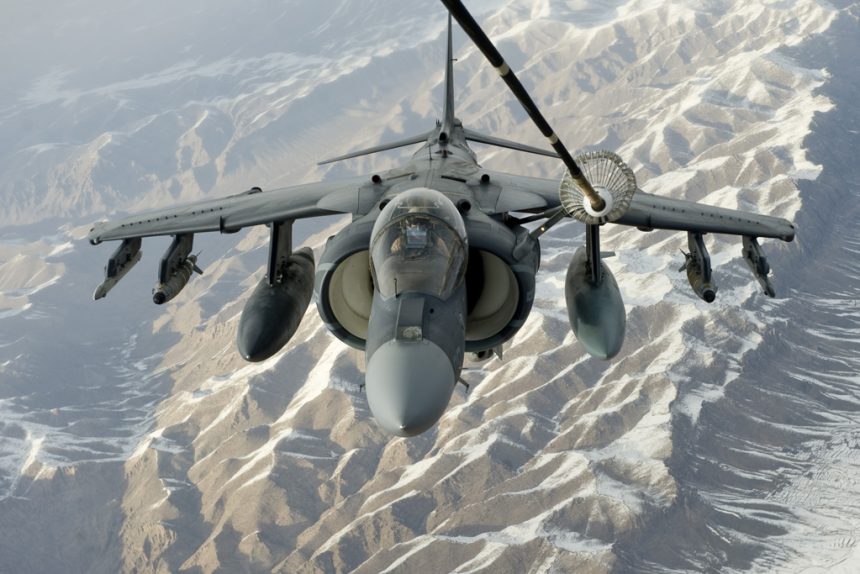As already explained, the recent Taliban attack on Camp Bastion, that cost the U.S. the worst air loss to enemy fire in one day since the Vietnam War, almost wiped out the entire U.S. Marine Harrier force in Afghanistan: besides killing two Marines, including the Commanding Officer of Marine Attack Squadron (VMA) 211, six AV-8B+ aircraft were destroyed and two more severly injured.
Since the VMA-211 “Avengers” had deployed to Afghanistan with 10 airframes, only two Harriers survived the insurgent attack in one of the strategical airbases in Afghanistan (aircraft that were immediately returned to the U.S.).
In other words, in a matter of a hours, the U.S., that had moved VMA-211 from Kandahar to Camp Bastion on Jul.1 to have the planes closer to where the troops need support, not only lost one of its most valuable CAS (Close Air Support) platforms in Afghanistan, but also about 1/15th of the entire American Jump Jet fleet.
Even though you may believe that the loss of 8 Harriers is not a big deal when you have a fleet of 120+ such planes, you have to consider that about 15 planes are TAV-8B two seater jump jets used for training purposes, along with about the same amount of single seaters.
Moreover, of the remaining Harriers (about 100), not all airframes can be used in combat with the same effectiveness, because the U.S. Marine Corps, along with the upgraded AV-8B+ (like those destroyed at Camp Bastion), that features the APG-65 Radar and the Litening pod, flies also the less capable AV-8B.
Hence the extent of losses suffered in Afghanistan is higher than the 7 percent and could be a big deal for the U.S. Marine Corps that has to carefully ration the employment of the Harriers if it wants to keep the AV-8B+ in service beyond 2030, when it will eventually be replaced by the F-35B.
Well before the Camp Bastion attack, to increase the availability of spare parts and extend the life of the Harrier, the Marines procured second hand RAF Harrier GR9s.
The second generation AV-8B Harrier, developed in the first ’80s, was well suited for U.S. Marine Corps requirement for a Close Air Support aircraft able to give effective tactical support to amphibious landing operations. Over the years, it was also upgraded to carry AMRAAM missiles, JDAMs (Joint Direct Attack Munitions), and today the plane (operating also with both the Spanish and Italian Navy) is able to undertake CAS missions, naval Theater Air Defense and precision Air-to-Ground tasks.
That’s why the Harrier is so important for the U.S. Marine Corps.
Beyond the AV-8B+
The USMC and the Italian Navy plan to replace their Harriers with the F-35B, the STOVL (Short Take Off Vertical Landing) version of the JSF (Joint Strike Fighter) conceived for Jump Jet users: U.S. Marines, IT Navy and Royal Navy / Royal Air Force (the first “international” F-35 is the F-35B BK-01 / ZM135, that made its maiden flight in April 2012). Althought it’s not among the AV-8B+ operators, the Italian Air Force is expected to operate 15 F-35Bs along with 60 F-35As.
The STOVL aircraft will be a swing role platform suited to be effective in a net-centric environment, where it will perform both sensor and shooter roles. But it will not be fully operational before the late 2020s, and the USMC is planning to upgrade its Harriers in order to keep them in service until a significant amout of F-35Bs will be operational.
Not only the USMC will have to upgrade the jump jets.
Probably, both Spanish and Italian Navy will have no choice but to upgrade their Harriers, which could be really effective with SDBs (Small Diameter Bombs) and new avionics, considering that the Air Superiority within a naval group area of operations is provided by the combination of both airborne and ship-based capabilities.
Nevertheless, since it doesn’t partecipate to the JSF program, Spain will probably lose its embarked fixed wing component if it doesn’t acquire the F-35B.
Written with The Aviationist’s “Skipper”
Related Articles
- Commanding Officer of the Harrier squadron decimated at Camp Bastion among the Marines killed in the Taliban attack (theaviationist.com)
- Marine Attack Squadron loses eight Harrier jets in worst U.S. air loss in one day since the Vietnam War (theaviationist.com)
- Reaper drone and Apache helicopter involved in the Camp Bastion battle that wiped out the U.S. Marine Corps Harrier force in Afghanistan (theaviationist.com)
- Seeing the target through a Scout Sniper’s observation telescope (theaviationist.com)
- Camouflage color schemes: how many Marines can you count in this photo? (theaviationist.com)
- U.S. Marine Corps F/A-18C crashes at NAS Fallon, Nevada. The last of a series of Hornet incidents (theaviationist.com)
- U.S. amphibious assault ship to be moved into position to support Noncombatant Evacuation Operation in Libya? (theaviationist.com)







